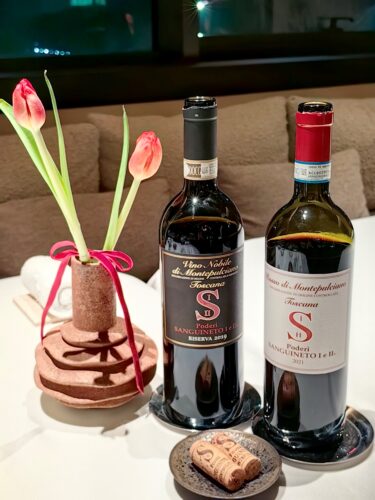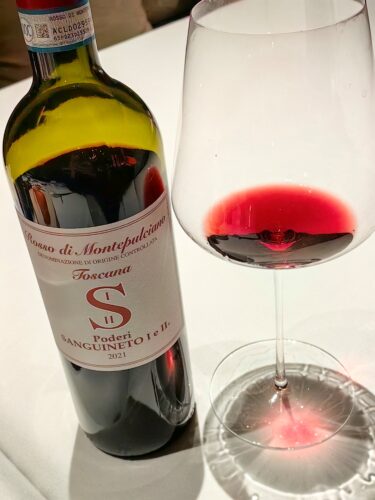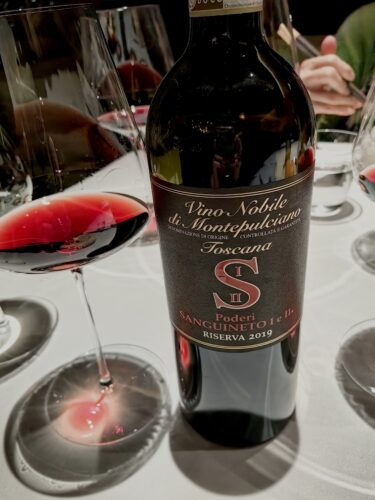Views: 96
這個夏天囘香港時,Arthur 很興奮的告訴我他最近歷盡艱辛才接觸到一家位於 Montepulciano 的隱世酒莊,並取得他們小量的 Vino Nobile。酒莊的名字叫 Poderi Sanguineto I & II(酒莊名字的由來見附錄)。他覺得他們有點天堂莊的影子。可惜酒還沒有運到我便囘了杭州。
最近有朋友從香港來杭,我便托他們為我帶了兩瓶來試試(2021 Rosso 與 2019 Riserva)。未等酒休息夠,我便急著開來試了。
這個夾在 Chianti 與 Brunello 之間的老產區我不多説了,大家有興趣可以看看三年前的一場隨意行專場的報告:VIPa-8 第 17 場 — Vino Nobile di Montepulciano。
回想我在 2014 年出席 Vinitaly 時曾偶然遇上這家酒莊,那是在一個很熱鬧的自然酒展場上。當時人太多了,我擠不進去,便轉而去試其他莊,反正有很多聼也未聽過的莊可以試。想不到十年後有緣可以在家與他們重逢。
 我在元旦前後試了五天,發現酒的確與天堂莊有異曲同工之妙,最特別之處是:他們的 Rosso 不太 Rosso,Riserva 也不太 Riserva。
我在元旦前後試了五天,發現酒的確與天堂莊有異曲同工之妙,最特別之處是:他們的 Rosso 不太 Rosso,Riserva 也不太 Riserva。
2019 與 2021 是兩個不同的年份,不可以直接比較。根據 Eric Guido(Vinous),2019 是重量級年份:
They are dark and powerful, full of complexity, but with refined tannic profiles. This will be a vintage for the cellar that we will talk about for a long time.
至於 2021,則似乎是個充滿陽光的年份:
The 2021s are intense, rich and powerful wines from a warm yet more balanced year than 2020.
 果然,我喝到的 2021 Rosso 最強的特質是鮮活,那明亮的酸度有一飛衝天的感覺,跟天堂莊的 Rosso 有一絲絲形似,就是一種天然,不造作的風格,不過沒有天堂莊那麽通透。我這樣說並非在貶低他們,而是說他們恰好表達了不同的風土特性。Montepulciano 沒有 Montalcino 那麽暖和,成熟度自然沒有那麽透徹,故彷佛多了一層不透光的砂紙。
果然,我喝到的 2021 Rosso 最強的特質是鮮活,那明亮的酸度有一飛衝天的感覺,跟天堂莊的 Rosso 有一絲絲形似,就是一種天然,不造作的風格,不過沒有天堂莊那麽通透。我這樣說並非在貶低他們,而是說他們恰好表達了不同的風土特性。Montepulciano 沒有 Montalcino 那麽暖和,成熟度自然沒有那麽透徹,故彷佛多了一層不透光的砂紙。
 相比之下,2019 Riserva 開始的時候顯得很深沉,頭兩天香氣一直沉在杯底,令我馬上想起 Le Chiuse。Rosso 酸爽,類似小紅莓,Riserva 的果味卻裹在厚厚的一層泥土裏頭,更多是森林中樹木的味道。讓我驚喜的是,他在第三天幾乎完全打開了。
相比之下,2019 Riserva 開始的時候顯得很深沉,頭兩天香氣一直沉在杯底,令我馬上想起 Le Chiuse。Rosso 酸爽,類似小紅莓,Riserva 的果味卻裹在厚厚的一層泥土裏頭,更多是森林中樹木的味道。讓我驚喜的是,他在第三天幾乎完全打開了。
兩兄弟最有趣的表現也在第三天。讓我説一説這經過:
第一天果日,Rosso 獨領風騷,有活力,有果而多汁,但絕非簡單。借用 Matt Kramer 對 Chambolle Musigny 的概括(deft 而非 light),我會說他很輕巧而非單薄。Riserva 卻一直悶不發聲似的(brooding),一大團黑泥土,果與酸都不太明顯,不過沒有 Riserva 級的 Chianti Classico 那種密閉感,後者我常覺得更像未打開的 Burgundy Grand Cru。兩者之間的分別又是風土使然 — Chianti 的氣候比 Montepulciano 更大陸性,更陰冷。
所以兩款酒都讓我們喝到 Montepulciano 的風土特性,也就是 Burton Anderson 巧妙的概括:
Only rarely does Vino Nobile match Brunello’s heroic dimensions, yet at its best it shows some of the latter’s structure with the complexity and finesse of reserve Chianti – a combination that ought to make it as noble as a Tuscan wine could be.
第二天仍是果日,兩者同有量變 — Rosso 添了重量,仍然鮮活無比,Riserva 則有些看頭了,果登場了,不過仍然厚重,相比之下酸度似乎欠了一點點。
第三天的果日我們見到從量變到質變的飛躍,有如我們今年在杭州過冬天的感覺。寒潮來了,我們躲在家裏,開足了暖氣。冰凍多日之後終於迎來陽光燦爛的一天,便連忙換上薄一點的衣服飛奔到郊外,陽光之下不光身子暖和舒服,連野草也像上了油一樣,亮堂堂的,看著更覺溫暖。Rosso 與 Riserva 就如冬日遇暖陽,完全敞開了,而且喝起來竟然越來越相似了!Rosso 比起第一天豐富多了,雖然果感與酸度仍然稍爲突出,那是蠻自然的由於加氧而發生的變化。更奇妙的是 Riserva,那天像脫下了大棉襖,換了一身運動服,肌肉比 Rosso 稍爲多一點,像個跑步運動員而非舉重高手,完全不是年輕 Chianti Riserva 那種拒人千里的套路。我突然叫了出來:他們的 Rosso 不太 Rosso,Riserva 也不太 Riserva!兩者都有種從容不逼,自然流暢的風格, 叫他們 Rosso 或 Riserva,猶如稱呼一對兄弟為老大與老二,出生或有先後之分,卻無高低之別。你可以說他們平衡、和諧或優雅,但這些名號已不重要了,稱他為來自 Montepulciano 的 Nobile 便可。
其後兩天都是根日,兩者感覺都重了,礦物味蓋過果,但他們之間的差別並不如 Brunello 或 Chianti 的基本版與 Riserva 那麽大,至於他們的一點分別究竟來自葡萄 “等級” 還是年份,暫時可以存疑。我個人認爲更多是由於年份和多放兩年所致。

圖片來自:https://www.louisdressner.com/
我對這家酒莊的興趣更大了,便重新看了 Arthur 當初發給我的資料,並上網看了代理商對他們的介紹(請看附錄)。最精彩的是幾段配了英語字幕的訪問。莊主 Dora Forsoni 說她愛上 Montepulciano 的 Sangiovese(當地的品種叫 Prugnolo Gentile)所特有的優雅,優雅得飯桌上你不會覺得需要喝點水。第一口你可能會覺得有點水汪汪,但入口後你會慢慢感到酒的勁度,整個口腔都開始緊綳起來,她自己到最後會上了癮一樣的杯莫停(like a drug)!
她講的正是我的經歷,但我喝得慢,這兩瓶新酒要等到第三天才令我杯莫停!
讓我們重溫 Burton Anderson 的概括:
Only rarely does Vino Nobile match Brunello’s heroic dimensions, yet at its best it shows some of the latter’s structure with the complexity and finesse of reserve Chianti – a combination that ought to make it as noble as a Tuscan wine could be.
Dora 追求的是優雅,對她來説,有勁度也不能失優雅。用 Burton 的話,便是複雜度與細膩要集於一身,這才是歷史上稱爲貴族酒應有的氣質。憑我試過的兩款酒,Dora 做到了。正是這種中庸的特質才足以令這個小產區躋身於比他們大得多的 Brunello 與 Chianti 之間仍能佔上超然的席位。
我像偵探一樣,越查越覺得有趣。我發現這個莊連歷史都跟天堂莊有些類似。與天堂莊的 Florio 一樣,Dora 也是第二代,她父親 Federico 在 1958 年買下農莊,初時只釀小量酒作自用。最小的女兒 Dora 在 1968 年開始跟爸爸務農,爸爸 1983 年去世後全面接管。
再看看天堂莊。Manfredi Martini 在 1956 年買下了 Montalcino 之北的小農莊 Il Paradiso,比 Federico 早兩年。Florio 在 1971 年開始跟 Manfredi 在田裏學習,比 Dora 晚 3 年,兩年後與 Manfredi 的女兒 Rosella 結婚,之後岳父與 Federico 一樣在 1983 年去世,自此他與太太 Rosella 跟 Dora 一樣開始打理酒莊。
所不同者,Florio 接手以後便開始向社會介紹天堂莊,但 Dora 要等到 1997 年才開始。這裏有個很有趣的故事。話説 1996 年,Dora 在清理父親遺物時發現了幾瓶父親珍藏的酒,上面沒有記錄年份,但 Dora 推斷應該是 1970 年代後期所出。Dora 一嘗之下發現放了二十年的酒狀態依然很好,這令她動了念頭與社會大衆分享他們土地的饋贈。
酒莊的故事與幾段珍貴的訪問在此:
https://www.louisdressner.com/producers/poderi%20sanguineto%201%20&%202
兩家酒莊的釀酒方法同樣與別不同。
我記得很清楚 Florio 跟我説過他們的小葡萄園可以分成七片,每片都不一樣,但他們每年把所有葡萄一起發酵,三款酒 Rosso,Brunello 與 Brunello Riserva 的差別只在桶陳的長短。
Dora 的做法是她把所有葡萄都先標記為 Vino Nobile,每年要待她品試過每一桶以後才決定哪一桶是 Rosso(一年桶陳),哪一桶是 Vino Nobile(兩年桶陳),哪一桶是 Vino Nobile Riserva(三年桶陳)。她把她的做法簡單稱爲 “一個年份,一種酒,三種表達方式”(un’annata, uno vino, tre espression “one year, one wine, three expressions”)。
她的做法與 Florio 只有一點點的差異。她似乎用了近乎隨機的方法(可能按採收的先後)來分開原來便有的不同表達能力的葡萄,強一點的讓他在灌瓶前多吸一點氧氣。因爲原材料是大致同質的葡萄,桶陳的作用不過把過於活躍的孩子多施加點管教,待他們長大後都會懂規矩,遵循 “優雅” 的校訓。
或者可以這麽說:Florio 的哲學是莊子的齊物論,而 Dora 則尊重大自然的差異而因材施教。至於流行的做法則是精英主義或優生學:通過刻意栽培和嚴格篩選,把潛力最大的葡萄與較小的葡萄嚴分等級,結果是精英被酒評人叫好,價錢更貴,但往往放很多年都不容易喝(用 Dora 的話便是要頻頻喝水),基本款卻有時候過於簡單。這種變化隱隱透露了人類從農業社會過渡到工業時代的轉變。
我不想在這裏討論孰優孰劣,不過我覺得葡萄酒世界容納得下甚至極度需要保留 Florio 與 Dorio 這種活化石。他們對大自然本真的追求處處提醒我們大自然而非科技才是人類真正的母親。人對大自然應該取之有道,讓控制欲無節制的發展下去,等著我們的是滅種之災。
附錄
酒莊介紹
來自代理商網頁:https://www.bowlerwine.com/producer/sanguineto
Poderi Sanguineto I & II is Dora Forsoni’s 50-hectare family estate in Montepulciano in southern Tuscany. The “I & II” is a reference to the property’s origin as a feudal farm divided into 8 sharecropping parcels: Sanguineto lies on parcels 1 & 2. Just 6 of those 50 hectares are planted to vines. Dora started working in the vineyard alongside her father back in 1968. He taught her how to tend their old vines of Prugnolo Gentile (the Montepulciano variant of Sangiovese), Mammolo, Canaiolo and Nero Toscano—organically farmed always—and how to make very traditional wines. But he sold off most of the fruit in bulk; Dora scrapped that practice in 1997 and began bottling Sanguineto wines for the first time.
Dora walks and works in the vines all day every day and has a very keen eye and confident touch. There are zero chemicals used here and the soils are worked up to 3 times per year. Treatments are entirely organic and relatively few in application compared to those of her neighbors. Dora even revitalizes very old vines by cutting them off at their base and allowing a new vine to grow from the old trunk, a very old-fashioned and rare local practice; any brand-new plantings are selection massale. Organic olive trees (harvested for the pressing of oil) and wildlife (harvested for the dinner table) abound in the vineyard.
Harvest is by hand. The fruit is fully destemmed, gently enough that many berries remain whole. The pressing is long and slow in order to get carefully to the meat of the grape nearest the seeds; Dora feels that it is from here that the sweetest, more complex flavors can be elicited. The must is fermented spontaneously with indigenous yeasts in concrete vats; aging takes place in variously sized oak botti. Interestingly, only one red wine is vinified—it is always declared at harvest as a future Vino Nobile di Montepulciano.
But as the different vessels of the wine evolve, Dora decides what will be bottled as Rosso di Montepulciano,“regular” Vino Nobile and sometimes Vino Nobile Riserva and then ages them for a total one, two and three years respectively. She is adamant about her philosophy and practice of un’annata, uno vino, tre espressioni (“one year, one wine, three expressions”) and considers any pre-determining or selecting in the vineyard to be anathema to transparency of terroir and vintage. Dora’s wines, like their maker, are not shy. They are earthy, robust and expressive, with a striking purity that is so rare in Montepulciano wines today. Sanguineto is truly singular.
多謝老師拆解了我不明所以的,表達了我不懂說的